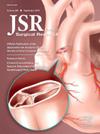普通外科门诊手术后的实时疼痛控制教育:随机对照试验
IF 1.8
3区 医学
Q2 SURGERY
引用次数: 0
摘要
阿片类药物相关的发病率和死亡率持续上升,手术通常是患者第一次接触阿片类药物。很少有干预措施集中在门诊设置的实时教育,而患者正在经历疼痛。研究了短信服务(SMS)调查与实时阿片类药物使用教育(SMSE)和不(SMS)对门诊术后阿片类药物使用的影响。方法:一项双盲随机对照试验纳入了2020年1月1日至2021年1月2日接受门诊普通外科手术的成年人(≥18岁)。术后10天,参与者每天收到自动短信或短信。主要结局包括口服吗啡当量(OMEs)中阿片类药物的总使用和总疼痛评分。通过实时短信收集患者反馈数据。结果:160例患者随机分为SMS组(n = 82)和SMSE组(n = 78)。患者人口学/临床特征和手术类型相似。在SMS和SMSE之间,总疼痛评分(25[四分位间距(IQR): 25.0]对31 [IQR: 35.7], P = 0.291)或总OME使用(15.5 mg [IQR: 37.5]对15.8 mg [IQR: 45.6], P = 0.762)无差异。总OME增加与年龄较小(P = 0.001)、阿片类药物处方(P = 0.001)和术前阿片类药物使用(P = 0.018)相关。总疼痛评分和OME使用较低的患者满意度较高,阿片类药物处方差异无统计学意义(P = 0.352)。亚组分析显示,SMSE组开放疝修补患者的OME使用较低(0 mg [IQR: 0] vs . 14.2 mg [IQR: 11.6], P = 0.004)。结论:通过短信进行实时阿片类药物使用教育并没有导致阿片类药物使用的差异,但作为一种沟通和反馈模式,其接受率很高。这一发现应该鼓励进一步优化SMS工具,以快速识别疼痛控制不足的患者,同时促进适当的阿片类药物使用和处置。本文章由计算机程序翻译,如有差异,请以英文原文为准。
Real-Time Pain Control Education After Outpatient General Surgery: A Randomized Controlled Trial
Introduction
Opioid-related morbidity and mortality continue to rise with surgery often serving as the first exposure to opioids for patients. Few interventions focus on real-time education in the outpatient setting while patients are experiencing pain. The effect of short-messaging service (SMS) surveys with real-time opioid-use education (SMSE) and without (SMS) on outpatient postoperative opioid use was studied.
Methods
A double-blinded randomized controlled trial enrolled adults (≥18 y) who underwent outpatient general surgery procedures from January 1, 2020, to January 2, 2021. Participants received an automated daily SMS or SMSE for 10 d postoperatively. Primary outcomes included total opioid use in oral morphine equivalents (OMEs) and total pain scores. Data were gathered via real-time SMS patient responses.
Results
One hundred sixty patients were randomized to SMS (n = 82) or SMSE (n = 78). Patient demographic/clinical characteristics and surgery type were similar. Between SMS and SMSE, there were no differences in total pain scores (25 [interquartile range (IQR): 25.0] versus 31 [IQR: 35.7], P = 0.291) or total OME used (15.5 mg [IQR: 37.5] versus 15.8 mg [IQR: 45.6], P = 0.762). Increased total OME correlated with younger age (P = 0.001), opioids prescribed (P = 0.001), and preoperative opioid use (P = 0.018). Higher patient satisfaction was observed in patients with lower total pain scores and OME used, with no difference in opioids prescribed (P = 0.352). Subgroup analysis revealed open hernia repair patients in the SMSE group had lower OME used (0 mg [IQR: 0] versus 14.2 mg [IQR: 11.6], P = 0.004).
Conclusions
Real-time opioid-use education via SMS did not lead to a difference in opioid use, but demonstrated a high acceptance rate as a mode of communication and feedback. This finding should encourage further optimization of the SMS tool to rapidly identify patients with inadequate pain control while promoting appropriate opioid use and disposal.
求助全文
通过发布文献求助,成功后即可免费获取论文全文。
去求助
来源期刊
CiteScore
3.90
自引率
4.50%
发文量
627
审稿时长
138 days
期刊介绍:
The Journal of Surgical Research: Clinical and Laboratory Investigation publishes original articles concerned with clinical and laboratory investigations relevant to surgical practice and teaching. The journal emphasizes reports of clinical investigations or fundamental research bearing directly on surgical management that will be of general interest to a broad range of surgeons and surgical researchers. The articles presented need not have been the products of surgeons or of surgical laboratories.
The Journal of Surgical Research also features review articles and special articles relating to educational, research, or social issues of interest to the academic surgical community.

 求助内容:
求助内容: 应助结果提醒方式:
应助结果提醒方式:


